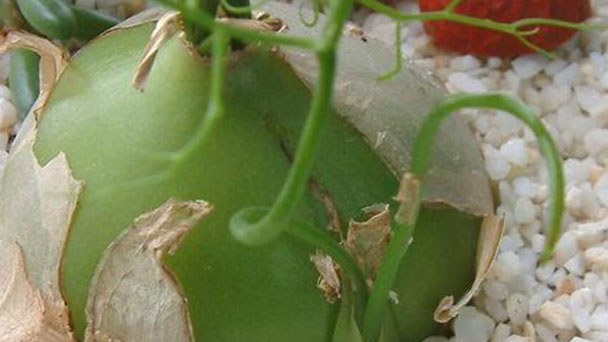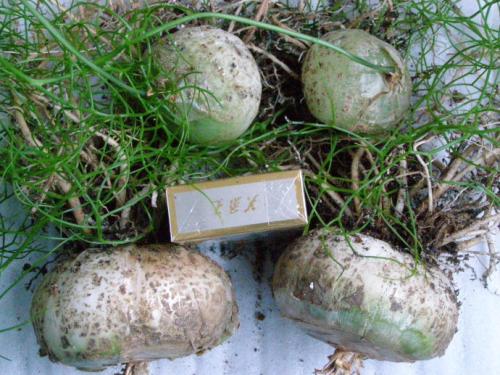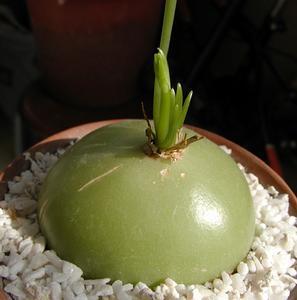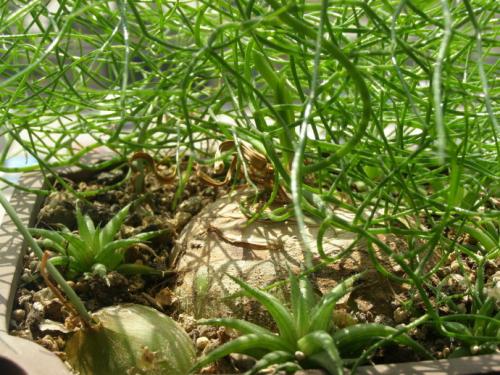Climbing Onion Plant (Bowiea Volubilis) Profile: Info, Care & Propagation Guide
Written by Maggie
Dec 07 2021

The Climbing Onion plant, scientific name Bowiea volubilis, is found in arid regions of southern Africa and has a large fleshy bulb. It is also called Climbing Sea Onion Plant. Climbing Onion maximum diameter is up to 20 ~ 30 cm, the skin light green, shiny.
Climbing Onion Picture

Characteristics of Climbing Onion
Bowiea Volubilis are perennial fleshy herbs like Climbing Onion. Climbing Onion plant has lith large light green fleshy corms, 20 -- 30 cm in diam.
The top of the bulb has clusters of asparagus-shaped, elongated green branches, which are twined and Climbing, with small green linear leaves which fall off in the dry season. The flowers are green and white and only 0.8 cm in size.
Ecological Habits of Climbing Onion
Climbing Onion plant (Bowiea volubilis) likes cold, cold resistance and heat resistance are slightly poor, like bright light, avoid direct sunlight; The climbing onion is a dormant type while the Climbing Onion is a hibernating type.
How to Care for Climbing Onion Plant
Transplant Climbing Onion
Seedlings plate or have several years of big plant pots, in pelvic floor in the first 2-3 cm thick coarse-grained matrix as a filter layer, cover Climbing Onion with full of rotten organic fertilizer as basal, the thickness of about 1 to 2 minutes, and then cover with a thin layer of the substrate, about 1 ~ 2 cm thick, and then into the Climbing Onion, in order to separate the fertilizer from the root, avoid burning roots. Use one of the following substrates for the pot: garden soil: slag = 3:1; Or garden soil: medium river sand: sawdust = 4:1:2; Or paddy soil, pond mud, leaf rot soil in one kind. Pour permeable water once after the basin, and put Climbing Onion in the shade environment for maintenance for a week. When the seedlings of Climbing Onion are transplanted, dig the planting hole first, sprinkle a layer of organic fertilizer at the bottom of the planting hole as base fertilizer (base fertilizer), the thickness is about 4-6 cm, and then add a layer of soil and put the seedlings, in order to separate the fertilizer from the root system, to avoid root burning. Put into the seedlings, backfill the soil, cover the root system, and foot the soil, pouring a permeable.
Climbing Onion Humidity Care
Climbing Onion plant likes wet or semi-dry climate environment, the relative temperature of the air in the growth environment is required to be 50 ~ 70%, the relative humidity of the air is too low at the lower part of the leaves yellowing, falling off, the upper leaves dull.
Climbing Onion Temperature Care
Because climbing onion plant is native to subtropical regions, it is very strict in winter temperature and stops growing when the ambient temperature is below 8℃.
Climbing Onion Light Requirements
The ability to adapt to light is strong. Put bowiea volubilis in indoor maintenance, as far as possible in the place with bright light, such as the living room with good daylighting, bedroom, study and other places. After indoor maintenance for a period of time (a month or so), it is necessary to move Climbing Onion to the outdoor shade (winter heat preservation conditions) of the place for maintenance for a period of time (a month or so), so alternate.
Climbing Onion Watering
For potted Climbing Onion plants, in addition to adding organic fertilizer on the pot, in the usual maintenance process, but also appropriate fertilizer and water management. Spring, summer and autumn are the peak seasons for its growth. The interval period is shorter during sunny days or high temperatures, and longer during cloudy and rainy days or low temperatures or no watering. In winter, during the Climbing Onion dormant period, fertilizer and water control should be mainly performed.
For Climbing Onion planted in the ground, according to the drought in spring and summer, apply 2-4 times of fertilizer and water: first in the root neck outside 30-100 cm open a circle of the small ditch (the bigger the plant, the farther from the root neck), ditch width and depth are 20 cm. Sprinkle 25-50 jin of organic fertilizer into the ditch, or 1 ~ 5 two particles of compound fertilizer (chemical fertilizer), and then pour permeable water. After the winter before the spring, according to the above method to fertilize again, but need not water.
Climbing Onion Pruning
Climbing Onion plant enters dormant in winter or half dormant period, want thin, disease insect, dead, too close wait for a branch to cut. It can also be combined with cuttings to finish the branches.
Soil for Climbing Onion
As long as it is properly maintained, Climbing Onion will grow very fast. When it reaches a certain size, it is necessary to consider changing Climbing Onion to a larger pot so that it can continue to grow vigorously. The proportion of culture soil and components can be used for changing pots: garden soil: slag = 3:1; Or garden soil: medium river sand: sawdust = 4:1:2; Or paddy soil, pond mud, leaf rot soil in one kind.
Repotting Climbing Onion
Put the pots of Bowiea volubilis on the ground and you want to change with slap dab around the basin, isolating the root trembled and the basin and wall, flower pot upside down on the left hand, left-hand index finger and middle finger gently clamp plant, resist basin along the wrist and fingers, right hand slapping your pelvic floor, then use your thumb from the top-down, bottom hole take root-soil to plants come out. When removed, pat the soil gently with your palms to remove excess soil.
Flower Pots for Climbing Onion
Choose a flowerpot of appropriate size for Climbing Onion plant, the bottom hole of the basin is covered with two tiles or thin foam pieces, to ensure that the soil is not washed out by the water, and to be able to let excess water can flow out in time. A layer of ceramsite or broken red brick is placed on top of the tile or foam to act as a filter layer, about 2-3 cm thick. Drainage layer and then put a fertilizer machine fertilizer, about 1-3 cm thick, fertilizer on a thin layer of the substrate, about 2 cm thick, in order to separate the root system and fertilizer, finally put the Climbing Onion in, fill nutrient soil, from the basin mouth about 2-3 cm can be left.
Climbing Onion Care Tips
After Climbing Onion open the flowers, tendrils gradually wither, now began to slowly entered hibernation, gradually reduce the water supply, to lull completely don't feed water, the plant can maintain the same in a basin (planting bulbs need to 2/3 above the earth's surface), in shade, the growing season comes, leaves out after the long, began to feed water, can be appropriately some organic fertilizer rates, next to the water supply from the bulb, try not to let the water accumulated in the center of the bulb, prevent rotting; In summer, it is necessary to pay attention to ventilation and light, and shade if necessary. In winter, it is necessary to pay attention to cold protection, and it can be placed indoors to avoid frostbite. When the Climbing Onion flower stem appears, be careful not to break it. If the Climbing Onion stem is removed, the vine will gradually dry out and the bulb will be cut in half and become smaller. However, it is possible to reproduce by dividing the bulb, but the bulb expands and takes several years to grow.

How to Propagate Climbing Onion Plant
Climbing Onion Propagation from Seed
1. Before sowing, we must first select the seeds of Climbing Onion plant. The seeds are well-chosen, which is directly related to the success of sowing.
It is best to choose the seeds of Climbing Onion that were harvested. The longer the seed is kept, the lower its germination rate.
2. The selection of full seeds, no incomplete or deformed seeds.
3. Choose seeds of Climbing Onion without pests and diseases.
Disinfection
Sterilization consists of two concepts, one refers to the disinfection of the seed, and the other refers to the disinfection of the substrate used for Climbing Onion sowing. The family is commonly used to seed disinfection of 60℃ or so hot water soak for a quarter of an hour, and then reoccupy lukewarm water sprout 12 ~ 24 hours. The best way to disinfect the substrate used for sowing is to put Climbing Onion in a wok and heat it up, which will kill any insects and diseases.
Sprouting
Soak the Climbing Onion seeds in warm water (about the same temperature as your face wash) for 12 to 24 hours, until the seeds absorb water and swell. For very common seeds that germinate easily, this job can be left out.
Sow
For by hand or other tools hard to clamp the tiny seeds, we can put the toothpick wet with water, at the end of the stick a grain by a grain of the seeds on the surface of the substrate, the substrate 1 cm thick, then the planting flower pot into the water, the depth of the water for the flower pot 1/2 ~ 2/3, the height of the water soak up slowly (the method known as "basin leaching method"); For larger seeds of Climbing Onion that can be held by hand or with other tools, place the seeds directly into the substrate and seed them at 3 x 5 cm intervals. After sowing, the substrate was covered with 2 ~ 3 times the thickness of seed grains. After sowing available sprayer, fine pore sprinkle sowing matrix quality wet, when the basin soil is slightly dry and then drenched, still should pay attention to the strength of watering can not be too big, so as not to flush up the seeds;
Management after sowing
After sowing Climbing Onion in late autumn, early spring or winter, when the cold wave and low temperature are encountered, the flowerpot can be wrapped with plastic film for the benefit of heat preservation and moisture preservation; After the seedlings of Climbing Onion are unearthed, the film should be uncovered in time, and the seedlings should be exposed to sunlight before 9:30 in the morning or after 3:30 in the afternoon, otherwise the seedlings will grow very weak. After most of the seeds of Climbing Onion have come out, it is necessary to thin the seedlings properly: diseased, unhealthy seedlings are pulled out so that the remaining seedlings have a certain space between each other; Most seedlings of Climbing Onion can be transplanted when they have three or more leaves.
Climbing Onion Propagation from Cuttings
Often in late spring and early autumn with the branches of the year for tender cuttings, or in early spring with the branches of last year for cuttings.
Substratum
The nutrient soil that uses cottage namely or the material such as soil of river sand, mud carbon. Family cuttings limited to conditions are difficult to get the ideal cuttings matrix, with coarse river sand also line, but before use to wash with water several times. Sea sands and saline areas of river sand do not use, they are not suitable for the growth of flowers and plants.
Selection of cuttings
For tender cuttings, in late spring to early autumn plant growth exuberant, choose that year's sturdy branches of Climbing Onion as cuttings. After cutting off the Climbing Onion branches, select the strong parts and cut them into sections 5 to 15 centimeters long, with more than 3 leaf segments in each section. When making cuttings, it should be noted that the upper cutting mouth is about 1 cm at the top of the top leaf section, and the lower cutting mouth is about 0.5 cm at the bottom of the bottom leaf section. The upper and lower cutting mouth should be flat (the knife should be sharp). Carrying on hard cuttings, after early spring temperature rise, select last year's robust branches to do cuttings. Each cutting usually retains 3 ~ 4 segments, and the cutting method is the same as that of shoots cutting.
Management after cutting
The optimal rooting temperature of cuttings ranged from 20℃ to 30℃, and it was difficult and slow when the temperature was lower than 20℃. When the temperature is higher than 30℃, the upper and lower cuttings are susceptible to pathogen infection and rot, and the higher the temperature is, the greater the proportion of rot. Cutting after low temperature, insulation measures are mainly used to use the film to cottage pot or container wrapped up; Cuttings after the temperature is a too high temperature, cooling measures are mainly to shade cuttings, to cover 50 ~ 80% of the sun, at the same time, to spray cuttings, 3 ~ 5 times a day, the number of sunny day higher spray is more, rainy day temperature lower temperature is larger, the number of sprays is less or not spray.
Humidity
The relative humidity of air must be maintained at 75 ~ 85% after cutting. The basic requirement for the rooting of cuttings is to ensure that the cuttings are fresh and can be photocopulatively used to produce the rooting material before they are rooting. But not rooting cuttings is unable to absorb enough water to maintain the water balance in the body, therefore, must be to reduce the cutting by spray evaporation: under the condition of a shade, spray to the cuttings, 3 ~ 5 times a day, sunny day temperature, the higher the injection, the more spray rainy day temperature, the lower the number of less or not. But if sprayed too much, the cuttings are susceptible to disease and rot, because many kinds of bacteria are present in water.
Light
Cuttings cannot be propagated without sunlight, because cuttings will continue to photosynthesizing to produce nutrients and rooting materials to supply their rooting needs. However, the stronger the light, the higher the temperature inside the cuttings, the more vigorous the transpiration of the cuttings, the more water consumed, which is not conducive to the survival of the cuttings. Therefore, after cutting must block out 50 ~ 80% of the sun, to be root grow out, and then gradually remove the shading net: sunny day at 4:00 PM in addition to the shading net, the next day before 9:00 am covered with the shading net.
Climbing Onion Propagation from Layering
Take a strong branch of Climbing Onion and peel the bark about 15-30 cm below the top. The width of the cut should be about 1 cm, and the depth should be limited to just after the skin is peeled. Cut a piece of film 10-20 cm long and 5-8 cm wide, put some wet garden soil on it, and wrap up the part of the ring peel as if it were a wound. Tie the upper and lower ends of the film tightly and bulge up in the middle. Root in about four to six weeks. After taking root, the edge of the branch root system cut together, became a new plant.
Seed breeding
Climbing the onion seeds available to breeding, seed is a bit small, without covering, can live in mixed large subsidies organic cultivation soil 3.5 -inch basin, keep humidity, about 10 ~ 14 days or so of germination, growth during the special formula can be applied well kondo garden plants as fertilizer, about 12 ~ 18 months (about 1 ~ 2 cm) bulb, can be in basin, then pay attention to the cultivation and management, adequate light, moisture and fertilizer, let bulb expands year by year.

Species Taxonomy of Climbing Onion
Only 2 ~ 3 species, South Africa and Tanzania. Bulbs with large fleshy, most of the Climbing Onion bulbs above the ground, smooth green - white skin. Bulb apex clusters of slender green branches, leaves degenerate into linear, often caducous. The Climbing Onion flowers are small, yellow or green or white. Climbing Onion is a perennial herb, native to South Africa and Tanzania, its feature is that there is a big green bulbs, about 5 ~ 8 cm in diameter, thin shoots to grow from the bulb at the top, winding, climbing to high sample unkempt hair, leaves scaly degenerated into needle type, stem tendril sex branchedness, for the green, can be to 2 ~ 3 meters long, from the apex issued a green-white flowers, about 0.5 cm in diameter, petals 6, visible six stamens, and pistil in the center; one white Another species, similar to the Climbing Onion, has green bulbs about 10 to 15 cm in size and is named Climbing Onion.
Climbing Onion Plant Benefits
Application value
Climbing Onion (Bowiea volubilis) shape is peculiar, it is a famous representative species of succulent plant, is also one of the most popular representative species of stem succulent plant in the world. Climbing Onion light requirements are not high, very suitable for home cultivation.
Medicinal ingredients
The Climbing Onion plant is a well-known representative species of succulent plants with unique plant types. Climbing Onion unique appearance and robust growth habits, especially its low demand for light, make it suitable for indoor bright places and give you a feeling different from other flowers.
Latest Updated
- Benefits of Bugleweed - 7 Science-backed Health Benefits
- Bugleweed Dangers & Side Effects - Is It Poisonous?
- How to Plant Evergreen Trees - What You Should Know
- When to Plant Evergreens - Grow Guide for Evergreen Trees
- 12 Wonderful Evergreen Shrubs for Your Garden
- 12 Popular Evergreen Plants with Pictures for Beginners
- When And How To Prune A Lilac Bush Like a Pro
- How to Grow & Care for Lilac Vine (Hardenbergia Violacea)
- Japanese Lilac Tree (Syringa Reticulata) Care & Propagation Guide
- Shumard Oak Pros and Cons - What to Know
Popular Articles
- Winter maintenance of Antirrhinum Majus
- How to Grow Terminalia Mantaly Tree
- How to Grow and Care for Crossostephium Chinense
- How to grow Antirrhinum Majus in spring
- Peristeria Elata (Dove Orchid) Profile: Info & Care Guide
- Underwatered Snake Plant (Sansevieria Trifasciata) - Signs And How To Fix
- How to Care for Brazilian Jasmine Plant (Mandevilla Sanderi)
- How to Grow & Care for Graptopetalum Purple Delight in Summer
- Rosa Chinensis (China Rose): Plant Growing & Care Tips
- How to Care for Baby Sun Rose (Aptenia Cordifolia)